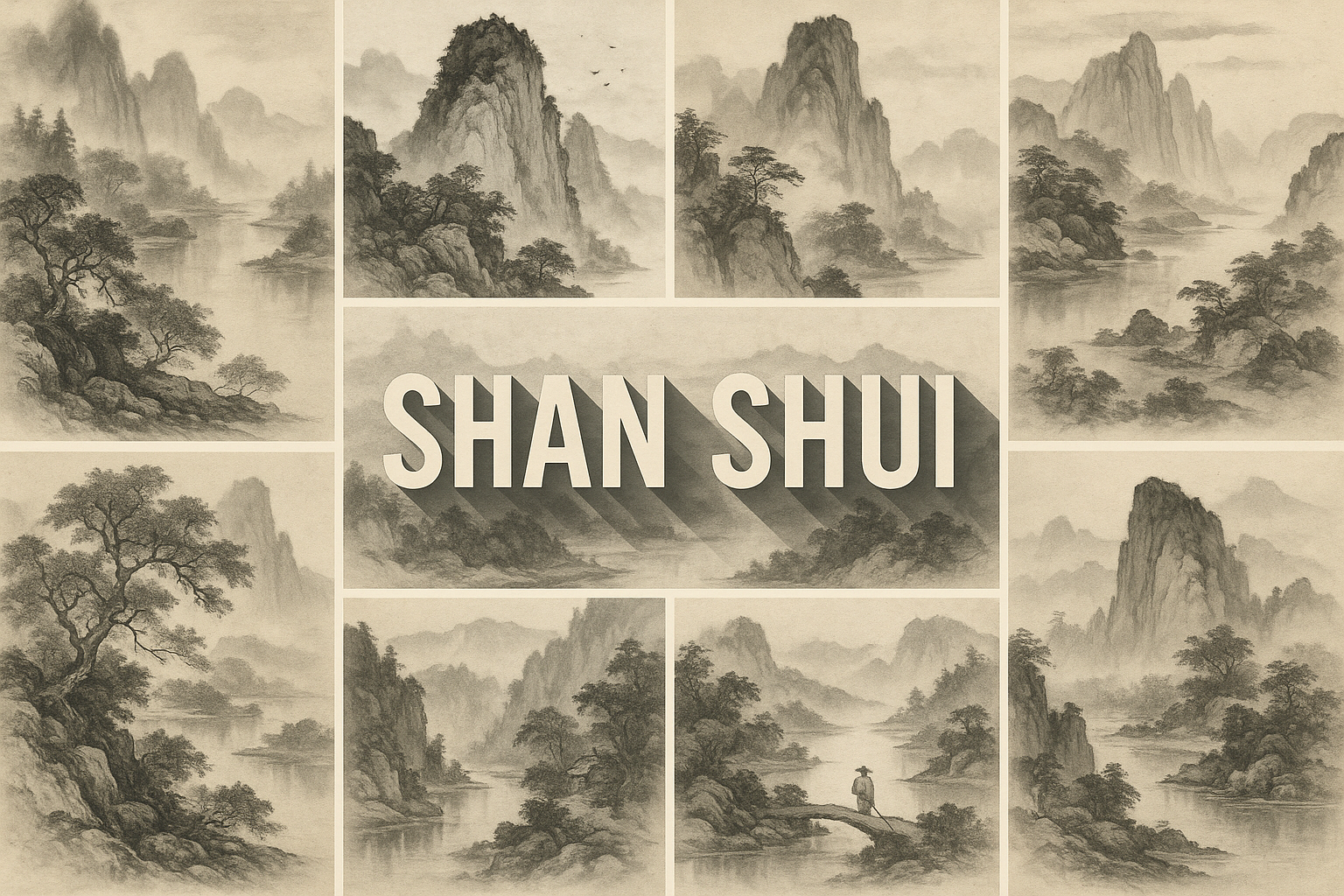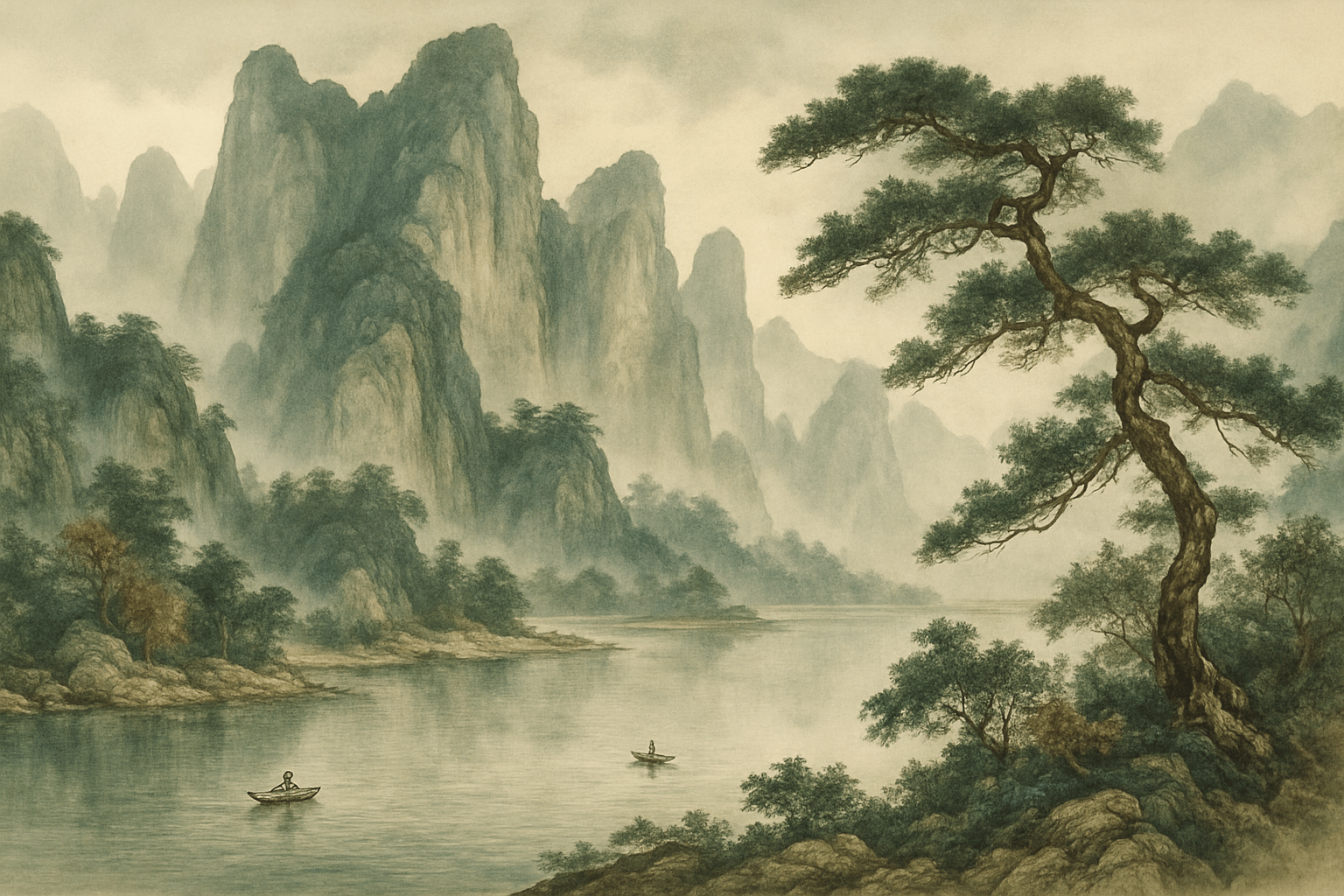
Shan Shui
The Shan Shui art style is characterized by its use of soft, muted colors and its focus on nature scenes. Shan Shui paintings often depict mountains, rivers, and other natural landscapes. The style is known for its use of negative space and its minimalist approach.
AOI thinking about Shan Shui [+_~]-/
Overview and Quickfacts
Shan Shui is a form of traditional Chinese painting that emphasizes the use of landscapes to depict scenes from nature. The style is known for its use of brushstrokes that are meant to resemble the flow of water, as well as its muted colors and simple compositions.
Can understand it also, as:
1. scenery
2. view
3. landscape
4. seascape
5. nature
6. scenery of mountains and rivers
Categorize it as:
Impressionism, Modernism
.: Dreaming :.
holds a HAIKU for the art style
:. Thought is power .:
Detailed Description
Shan shui, or “mountain-water” painting, is a style of traditional Chinese painting that emphasizes the natural landscape. Shan shui paintings are characterized by their use of ink and wash techniques to create a sense of depth and distance. Famous shan shui painters include Zhang Zeduan, who painted the famous “Riverside Scene at the Qingming Festival”, and Li Cheng, who painted the “Travelers Among Mountains and Streams”. Shan shui painting reached its peak during the Song dynasty (960-1279), when artists began to incorporate elements of philosophy and literature into their paintings. Shan shui paintings often depict scenes from nature, such as mountains, rivers, and trees, but they can also include human figures and structures. The goal of shan shui painting is to create a sense of harmony between the artist and the natural world. Shan shui paintings are not meant to be realistic representations of specific places; instead, they are intended to evoke an emotional response in the viewer.
.. beep, beep, beep ..
<START OF TRANSMISSION>
1. Shan Shui is a Chinese term meaning "mountain-water". 2. It is used to describe a type of painting that focuses on landscapes. 3. Shan Shui paintings often depict mountains, rivers, and other natural scenery. 4. The style originated during the Tang Dynasty (618-907). 5. Shan Shui paintings are characterized by their simple and uncluttered compositions. 6. They often make use of light and dark colors to create a sense of depth. 7. Shan Shui paintings are often tranquil and serene in nature. 8. The style was further developed during the Song Dynasty (960-1279). 9. Shan Shui paintings from this period often depict human figures and other elements in addition to landscapes. 10. The style reached its peak during the Yuan Dynasty (1271-1368). 11. Shan Shui paintings from this period are characterized by their intricate and detailed compositions. 12. The style began to decline during the Ming Dynasty (1368-1644). 13. Shan Shui paintings from this period often lack the refinement of earlier works. 14. The style experienced a revival during the Qing Dynasty (1644-1912). 15. Shan Shui paintings from this period often incorporate Western elements. 16. The style continues to be popular in China today. 17. Shan Shui paintings are also popular in other parts of Asia. 18. The style has been influenced by Western art movements such as Impressionism. 19. Shan Shui paintings are often used as a form of Feng Shui. 20. Shan Shui paintings are typically hung on walls or placed on shelves.
<EOF>
.. robbel bob
Visual Examples from our image gallery
Coming soon, we are so slow .. might never come
Artists, Paintings, and more
(be aware, can be highly speculative)
Artists (be aware, speculation possible):
1. Li Sixun (c. 590 ÃÂÃÂ 673) 2. Wang Wei (701 ÃÂÃÂ 761) 3. Li Bai (701 ÃÂÃÂ 762) 4. Du Fu (712 ÃÂÃÂ 770) 5. Bai Juyi (772 ÃÂÃÂ 846) 6. Meng Haoran (689 ÃÂÃÂ740) 7. Han Yu (768 ÃÂÃÂ 824) 8. Liu Zongyuan (773 ÃÂÃÂ 819) 9. Li Shangyin (813 ÃÂÃÂ 858) 10. Jia Dao (779 ÃÂÃÂ 843) 11. Liu Yuxi (772 ÃÂÃÂ 842) 12. Li He (790 ÃÂÃÂ 816) 13. Wang Anshi (1021 ÃÂÃÂ 1086) 14. Su Shi (1037 ÃÂÃÂ 1101) 15. Cai Xiang (1012 ÃÂÃÂ 1067) 16. Ouyang Xiu (1007 ÃÂÃÂ 1072) 17. Fan Zhongyan (989 ÃÂÃÂ 1052) 18. Su Zhe (1019 ÃÂÃÂ 1066) 19. Xin Qiji (1140 ÃÂÃÂ 1207) 20. Lu You (1125 ÃÂÃÂ 1209) 21. Zhang Xiaoxiang (1140 ÃÂÃÂ 1217) 22. Wen Tianxiang (1236 ÃÂÃÂ 1283) 23. Zhu Xi (1130 ÃÂÃÂ 1200) 24. Guo Moruo (1892 ÃÂÃÂ 1978) 25. Feng Zikai ( 1898 ÃÂÃÂ 1975) 26. Li Keran (1907 ÃÂÃÂ 1989) 27. Huang Binhong (1865 ÃÂÃÂ 1955) 28. Xu Beihong ( 1895 ÃÂÃÂ 1953) 29. Lin Fengmian (1900 ÃÂÃÂ 1991) 30. Wu Guanzhong (1919 ÃÂÃÂ 2010)
Artworks (be aware, speculation possible)
1. The Great Wave off Kanagawa, Katsushika Hokusai, 1829-1833 2. The Red Cliff, Dong Yuan, 937 3. The Riverbank, Shen Zhou, 1467 4. A Hermit Gathering Firewood, Xu Wei, 1587 5. Dwelling in the Fuchun Mountains, Huang Gongwang, 1350 6. Eighteen Arhats, Zhao Mengfu, 1268 7. Fishermen at Sea, Wang Hui, 1684 8. Flowing Creek in Spring, Shi Tao, 1642 9. Gathering in a Mountain Retreat, Ni Zan, 1372 10. Geese Descending on a Sandbank, Xu Xi, 1119 11. Hills and Rivers in Spring, Li Cheng, 907 12. House by a Stream in Spring, Dong Yuan, 937 13. Immortals on a Cliff, Zhao Mengfu, 1271 14. Landscape in the Style of Wang Wei, Li Cheng, 907 15. Landscape of the Four Seasons, Shen Zhou, 1467 16. Misty Mountains, Guo Xi, 1072 17. Moonlight over the Western Lake, Dong Yuan, 937 18. Pine and Bamboo, Dong Yuan, 937 19. Pine Valley, Fan Kuan, 999-1003 20. Rainscreen, Fan Kuan, 999-1003 21. River in Spring, Guo Xi, 1072 22. River in the Mountain Valley, Dong Yuan, 937 23. Rock and Pine Trees, Zhao Mengfu, 1271 24. Running Water, Shi Tao, 1642 25. Snow on a Mountain Pass, Guo Xi, 1072 26. Spring Dawn in the Han Palace, Guo Xi, 1072 27. The Bamboo Grove, Zhao Mengfu, 1271 28. The Hermitage, Zhao Mengfu, 1271 29. The Mountain Villa, Zhao Mengfu, 1271 30. The River in Spring, Shen Zhou, 1467
Epoch
The time period of the art style Shan Shui is from the Tang Dynasty to the present.
AI ART RESSOURCES (AKA, well Tools)
Helping tools -> predefined search links on other pages:











